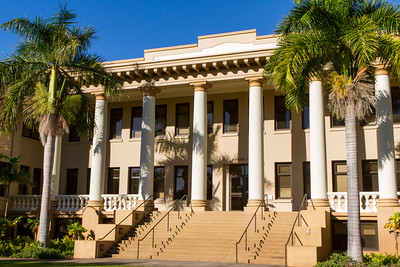

Building Information
| Property Number | 1002 | LEED Status | N/A |
| Address | 2465 Campus Road | Campus Map | Map |
| Year Built | 1949 | ‘Ili | Pilipili |
| Gross Square Feet | 40,699 | Building Signage | – |
| Abbreviation | HH | Floor Plan | Access Floor Plan |
| Building Zone | – | CAD/BIM Drawing | – |
| Hours of Operation | – | Arts & Culture | – |
| Parking Information | Parking map | Building Coordinator | – |
About
Hawaiʻi Hall was the first building of the University of Hawaiʻi system. Built in 1912 by Architect Clinton Ripley, Hawaiʻi Hall follows the Neo-Classical Style, which was also adopted by subsequent buildings around the Quad.
Additional Information
Historical:
Constructed on land formerly used for pig farms, Hawaiʻi Hall was the first building of the University of Hawaiʻi and originally housed most of the college’s operations. It was also the first building to receive electric lights so students and faculty could stay after sundown. A number of events in the buildingʻs long history on campus have also influenced University policies.
One incident outside of Hawaiʻi Hall in 1923 led to the banning of hazing on campus. From the University’s beginning, hazing practices prohibited freshmen from entering Hawaiʻi Hall via the stairs leading up to the front door. One morning in 1923, a group of freshmen boys tried to break this rule, causing a “tussle” between the group and some sophomore boys who tried to stop them. While most walked away from the incident, freshman George Paul sustained a broken neck from being pushed down the stairs, resulting in his death the following day. As a result, all hazing practices were banned across UH campuses.
During WWII, Hawaiʻi Hall was partially occupied by the U.S. Armed Forces Institute, although campus administration continued to operate out of the building. On February 25, 1942, about 160 male students of Japanese descent gathered on the building’s steps and sang the alma mater. Following, they announced themselves as the Varsity Victory Volunteers and petitioned the military to let them serve the war. The same students had been part of the Hawaiʻi Territorial Guard until they had been discharged and their draft status changed to 4c–enemy alien. Their petition at the steps of Hawaiʻi Hall led to the unit working under the Army Corps of Engineers and later disbanding with many members joining the newly formed 442nd regimental combat team.
Botanical:
Hawaiʻi Hall is ringed by a variety of palm trees that include the Sealing Wax Palm, Vanuatu Palm, Cuban Royal Palm, and Hurricane Palms. The stairs leading up to the main entrance are bordered by ʻākia shrubs, and the south side of the building is lined with Grand Crinum.
Renovations:
Termite damage led to renovations from 1980-1981, and a full demolition and reconstruction in 2002-2003, resulting in the structure standing today.
Departments
- N/A
Colleges
- College of Social Sciences
Common Spaces
- N/A
Related UH Links
Resources
- “History.” University of Hawaii System. Accessed August 8, 2024. Link.
- Kobayashi, Victor N. Building a Rainbow: A History of the Buildings and Grounds of the University of Hawaii’s Manoa Campus. Honolulu, HI: Hui O Students, University of Hawaii at Manoa, 1983.
- Ma Plant Finder. Accessed August 8, 2024. Link.
- Leineweber, Spencer. Rep. University of Hawaiʻi Campus Heritage Report. Honolulu, Hawaiʻi: The Heritage Center, 2008.
- pls4e. “Hawaii Hall.” SAH ARCHIPEDIA, June 17, 2019. Link.
- University of Hawaiʻi at Mānoa Campus Map. Accessed August 8, 2024. Link.